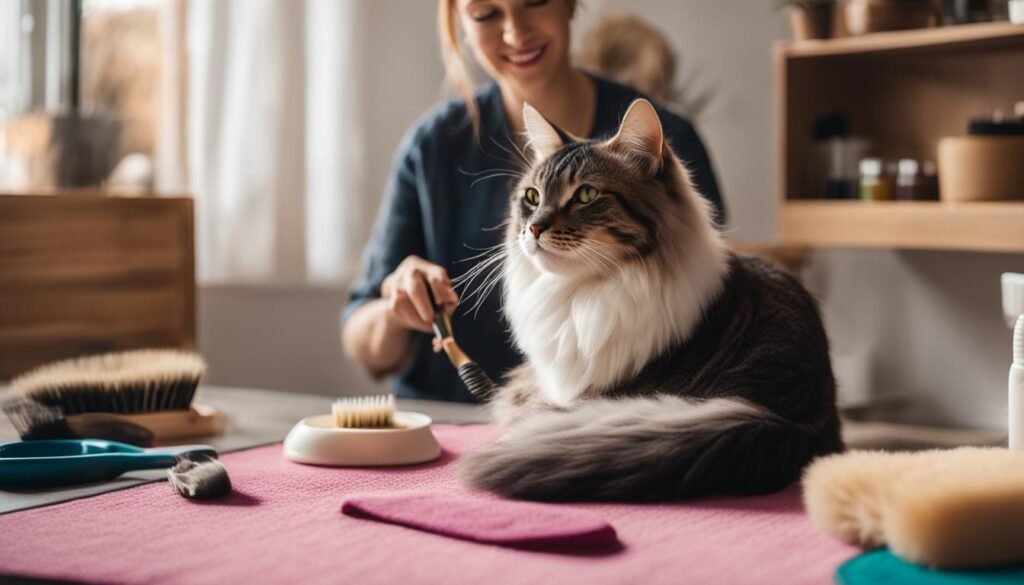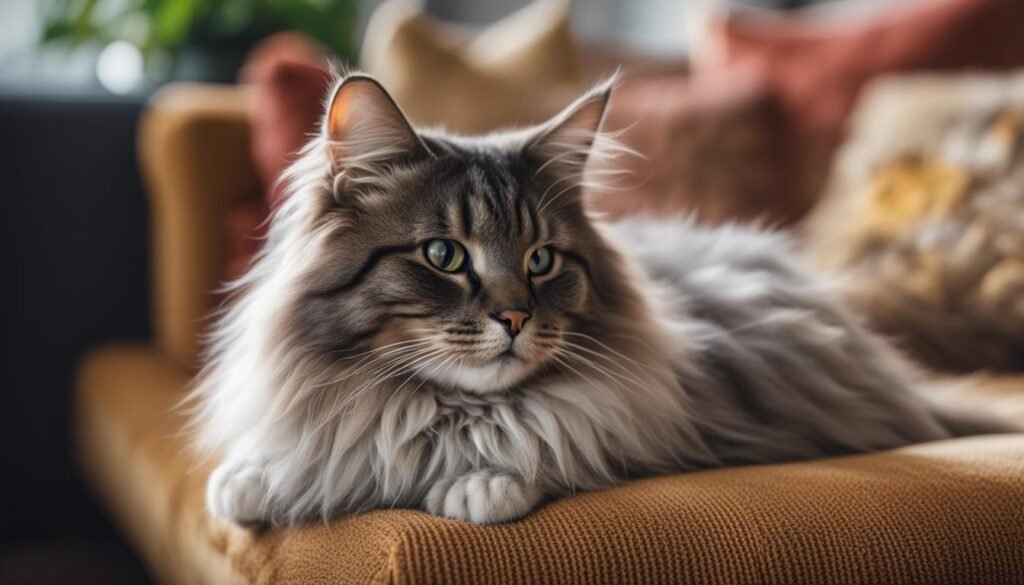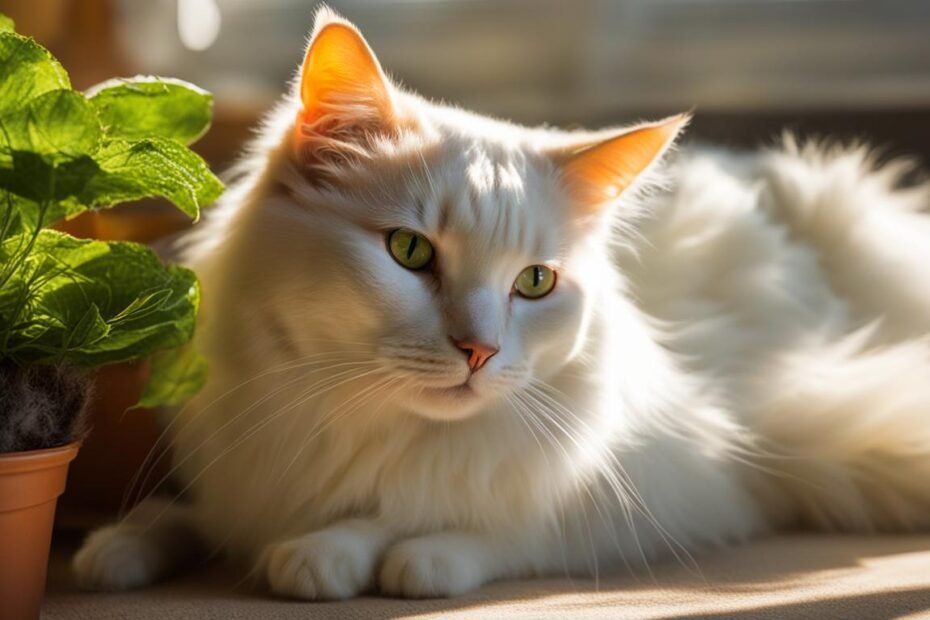Are you a cat owner concerned about your furry friend’s hairball troubles? You’re not alone! Hairballs are a common issue among cats due to their grooming habits. While you can’t completely prevent hairballs, there are ways to minimize them and ensure your cat’s well-being.
At Furry Friend Care, we understand the importance of keeping your beloved pet happy and healthy. In this article, we will explore effective methods for cat hairball prevention, including grooming techniques, recognizing hairball symptoms, and the use of hairball remedies. Let’s dive in and show those hairballs who’s boss!
Key Takeaways:
- Regular brushing helps in reducing loose hairs and preventing hairball formation.
- Interrupt excessive grooming sessions with activities or cuddles to discourage hairball development.
- Routine vet visits allow early detection of any underlying health issues related to hairballs.
- Consider incorporating hairball formula cat food or diet supplementation for hairball control.
- Consult with a veterinarian to determine the most suitable hairball remedy for your cat.
Why Do Cats Get Hairballs?
Hairballs are a common issue for cats due to their grooming habits. Understanding why cats get hairballs can help you take preventative measures to minimize them. Cats groom themselves by licking their fur, and during this process, they ingest loose hair, dander, and dirt. Most of the hair passes through their digestive system, but sometimes it accumulates in their stomach and forms a hairball.
Long-haired breeds, such as Persians and Maine Coons, are more prone to hairballs due to the length of their fur. National Hairball Awareness Day, held annually on April 25th, is dedicated to raising awareness about this issue and educating cat owners on ways to prevent and manage hairballs.
To further understand hairball formation and prevention, let’s take a closer look at cats’ grooming habits.
The Grooming Habits of Cats
| Grooming Behavior | Description |
|---|---|
| Licking | Cats groom themselves by licking their fur using their rough tongues which act as natural brushes. This helps to remove dirt and debris. |
| Ingestion | While grooming, cats unintentionally ingest loose hair, dander, and dirt. This hair is usually passed through the digestive system. |
| Hairball Formation | If the ingested hair does not pass through the digestive system, it may accumulate in the stomach and form a hairball. |
By understanding and addressing the grooming habits of cats, we can take steps to prevent excessive hairballs and promote the overall well-being of our furry friends.

Recognizing and Dealing with Hairballs
As a cat owner, it’s important to be able to recognize the signals of a hairball. One common sign is the sound of coughing and retching that cats make when trying to expel a hairball. If you notice your cat making these sounds, it’s likely that a hairball is causing discomfort. It’s important to note that occasional hairballs are usually not a cause for concern.
When your cat does bring up a hairball, it’s important to clean it up promptly. Hairballs are typically comprised of hair, saliva, and stomach acid, and can be messy to deal with. Use a paper towel or disposable gloves to remove the hairball from your cat’s environment. Make sure to dispose of it properly to prevent your cat from re-ingesting it.
“Cats that groom excessively and experience frequent hairballs may require additional attention and care.”
While most hairballs pass through the digestive system without any problems, it’s important to be aware of potential hairball blockages. If a hairball does not come up and gets stuck in the intestines, it can pose a serious health risk. If you notice signs of distress, such as loss of appetite, constipation, or vomiting, contact your veterinarian immediately for further evaluation and treatment.
Table: Common Hairball Signals and Actions
| Hairball Signal | Action |
|---|---|
| Coughing and retching | Monitor your cat, clean up hairballs, observe for potential blockages |
| Excessive grooming | Provide environmental enrichment, interrupt grooming sessions |
| Loss of appetite, constipation, vomiting | Contact your veterinarian for evaluation and treatment |
By recognizing the signals of hairballs and taking appropriate actions, you can help ensure your cat’s comfort and well-being. Regular monitoring, prompt clean-up of hairballs, and immediate veterinary attention if needed are key steps in dealing with hairball issues.
Preventing Hairballs: Regular Brushing
Regular brushing is a crucial step in preventing hairballs in cats. By incorporating this grooming habit into your cat’s routine, you can effectively reduce the amount of loose hairs that your cat ingests during self-grooming sessions. Not only does regular brushing help in preventing hairballs, but it also promotes a healthy coat and skin.
When brushing your cat, make sure to use a brush or comb specifically designed for their fur type. Short-haired cats may benefit from a slicker brush, while long-haired cats may require a wider-toothed comb or a brush with longer bristles. Brushing should be done gently to avoid causing any discomfort to your cat.
Aside from reducing loose hairs, regular brushing also provides an opportunity for bonding with your cat. Many cats enjoy the attention and grooming session, especially when it is done in a calm and relaxed environment. Make sure to provide treats, praise, or playtime as rewards to make the experience positive and enjoyable for your furry friend.
| Benefits of Regular Brushing | How to Brush Your Cat |
|---|---|
| Reduces loose hairs | Choose a brush or comb suitable for your cat’s fur type |
| Promotes a healthy coat and skin | Brush gently to avoid discomfort |
| Provides bonding time | Offer treats, praise, or playtime as rewards |
In conclusion, regular brushing is an effective method for preventing hairballs in cats. Not only does it reduce loose hairs, but it also promotes a healthy coat and provides valuable bonding time with your feline companion. Make sure to establish a regular brushing routine and use the appropriate tools for your cat’s fur type. By incorporating this simple habit, you can help ensure your cat’s well-being and minimize the occurrence of hairballs.
Discouraging Excessive Grooming
Cats that engage in excessive grooming are more prone to developing hairballs. To prevent this behavior, it’s important to interrupt lengthy grooming sessions and provide alternative activities or cuddles. By redirecting their attention, you can help reduce the amount of time they spend grooming.
One way to discourage excessive grooming is by offering stimulating toys. Interactive toys that require physical activity, such as feather wands or puzzle toys filled with treats, can keep your cat mentally and physically engaged, reducing the likelihood of boredom-related excessive grooming.
In addition to toys, environmental enrichment is essential. Create a cat-friendly environment by providing scratching posts, perches, and hiding spots. This allows your cat to fulfill their natural instincts and provides mental stimulation, preventing boredom-related behaviors like excessive grooming.
“Interrupting excessive grooming sessions and providing engaging activities can help break the cycle of excessive grooming and reduce the risk of hairball formation.” – Dr. Sarah Anderson, Feline Behavior Specialist
The Importance of Regular Playtime
Regular playtime is crucial in preventing boredom and excessive grooming. Set aside dedicated play sessions every day to engage your cat in interactive play. Use toys that mimic prey, such as feather toys or laser pointers, to stimulate your cat’s hunting instincts and provide an outlet for their energy.
By incorporating play into your cat’s routine, you can help prevent boredom-related excessive grooming and promote a healthy, active lifestyle. Remember to always supervise playtime and provide a variety of toys to keep your cat mentally stimulated and entertained.
Finding the Right Balance
It’s important to find the right balance between grooming and excessive grooming prevention. While grooming is a natural behavior for cats, excessive grooming can lead to hairballs and other health issues. By interrupting grooming sessions, providing alternative activities, and ensuring regular playtime, you can help your cat maintain a healthy grooming routine while minimizing the risk of hairball formation.
Remember, if you have any concerns about your cat’s grooming habits or hairball prevention, consult with a veterinarian for personalized advice and recommendations.

Routine Vet Visits
Regular vet checkups are crucial for maintaining your cat’s overall health and well-being. These routine visits not only allow veterinarians to monitor your cat’s growth and development but also provide an opportunity for early detection of any underlying health issues that may contribute to excessive hairball formation. By identifying and addressing these issues promptly, you can help prevent hairball-related complications and ensure your cat’s optimal health.
Benefits of Routine Vet Checkups:
- Early Detection: Routine vet visits enable veterinarians to identify any health concerns or abnormalities in their early stages. This includes detecting any potential gastrointestinal issues that may lead to hairball blockages.
- Preventative Care: Vets can provide personalized recommendations on how to prevent hairballs, including dietary changes, grooming techniques, or the use of specific hairball remedies.
- Vaccinations and Parasite Control: Routine visits ensure that your cat receives the necessary vaccines and preventative treatments for common parasites, which can contribute to overall health and well-being.
- Professional Advice: Veterinarians are a valuable source of information and can answer any questions or concerns you may have about your cat’s health, including specific hairball concerns.
“Regular vet checkups play a vital role in keeping your cat healthy and minimizing the risks associated with hairball formation. By maintaining a proactive approach to your cat’s healthcare, you can provide them with the best chance for a long, happy, and hairball-free life.” – Dr. Amanda Wilson, DVM
Remember, every cat is unique, and their healthcare needs may vary. It’s important to follow the recommended vaccination schedules and consult with your veterinarian for personalized advice tailored to your cat’s specific needs and circumstances.
| Recommended Frequency | Age and Health Condition |
|---|---|
| Annual | Healthy adult cats with no underlying health concerns |
| Biannual | Cats over the age of 7, senior cats, or cats with pre-existing health conditions |
| As needed | Emergencies, sudden health issues, or concerns about hairball-related complications |
By prioritizing routine vet visits, you can ensure that your cat receives the necessary care and attention to keep them healthy, happy, and free from the discomfort of hairballs.
Hairball Remedies
If your cat is prone to hairballs, there are various remedies available to help manage this common issue. By incorporating the right hairball remedies into your cat’s routine, you can reduce the frequency and severity of hairball formation. Here are some effective options to consider:
Hairball Formula Cat Food
One of the simplest ways to address hairballs is by feeding your cat a hairball formula cat food. These specially formulated diets contain natural ingredients that help reduce hairball formation. They often include fiber to aid digestion and promote the passage of hair through the digestive system. Look for reputable brands that meet your cat’s nutritional needs, and consult with your veterinarian for specific recommendations.
Diet Supplementation
In addition to hairball formula cat food, you can also consider supplementing your cat’s diet with natural remedies. Fiber supplements, such as canned pumpkin or psyllium husk powder, can help add bulk to your cat’s stool and aid in the elimination of hairballs. Another option is adding fatty acids like fish oil to your cat’s meals, as it can help lubricate the digestive system and promote the passage of hair through the intestines.
Homeopathic Remedies
For cat owners who prefer a more natural approach, homeopathic remedies can be an option. These remedies are often made from natural ingredients and can be added to your cat’s food. Some common homeopathic remedies for hairballs include slippery elm bark, marshmallow root, and chamomile. It’s important to consult with a veterinarian or a holistic veterinarian to determine the appropriate dosage and to ensure the remedy is safe for your cat.
Hairball Control Products
If your cat is resistant to dietary changes or supplements, there are various hairball control products available in the market. These products come in the form of soft chews, gels, or pastes and act as mild laxatives, helping hairballs pass more easily through the digestive system. Some products also have added ingredients to help reduce shedding and promote a healthy coat. It’s important to choose a reputable brand and follow the recommended dosage guidelines.
Remember, not all remedies may work for every cat, so it’s essential to monitor your cat’s response and consult with a veterinarian if you have any concerns. By combining the right remedies with regular brushing and routine veterinary care, you can effectively manage hairballs and ensure your cat’s overall well-being.
Conclusion
Cat hairball prevention is crucial for maintaining the health and well-being of your beloved feline companion. By incorporating effective methods such as regular brushing, discouraging excessive grooming, scheduling routine vet visits, and utilizing appropriate hairball remedies, you can significantly reduce hairball formation and ensure your cat’s overall health.
Regular brushing plays a vital role in preventing hairballs by removing loose hairs, dander, and dirt that cats would otherwise ingest and form into hairballs. Not only does this grooming activity reduce the risk of hairballs, but it also strengthens the bond between you and your furry friend.
It’s essential to discourage excessive grooming by interrupting lengthy grooming sessions with engaging activities or affectionate cuddles. Providing stimulating toys and environmental enrichment can also help prevent boredom-related excessive grooming, ultimately reducing the likelihood of hairball formation.
Additionally, routine vet visits are essential for monitoring your cat’s overall health and addressing any concerns related to hairballs. These checkups allow veterinarians to detect and manage any underlying health issues that may contribute to excessive hairball formation, ensuring your cat remains happy and healthy.
Remember, consulting with a veterinarian is crucial for selecting the most suitable hairball remedy for your cat. Whether it’s hairball formula cat food, diet supplementation, homeopathic remedies, or hairball control products, your veterinarian can guide you in making the right choices for maintaining your cat’s well-being and minimizing hairball management.
By implementing these effective methods and seeking professional guidance, you can successfully prevent hairballs, manage their impact on your cat’s health, and provide the best possible care for your feline companion.
FAQ
What causes hairballs in cats?
Hairballs are caused by cats’ grooming habits. When cats groom themselves, they often ingest loose hair, dander, and dirt, which can accumulate in their stomach and form a hairball.
How can I recognize a hairball in my cat?
Cats will often make coughing, retching, and gagging sounds when trying to expel a hairball. These sounds are usually a clear indication that your cat has a hairball.
Are hairballs a cause for concern?
Hairballs are usually not a cause for concern and can be dealt with by cleaning them up. However, if a hairball doesn’t come up and gets stuck in the intestines, it can cause blockages, which may require veterinary intervention.
How can I prevent hairballs in my cat?
Regular brushing is an effective method for preventing hairballs. By brushing your cat’s fur regularly, you can remove loose hairs, dander, and dirt that would otherwise be ingested and form hairballs.
How can I discourage excessive grooming in my cat?
To discourage excessive grooming, it’s important to interrupt lengthy grooming sessions with activities or cuddles. Providing stimulating toys and environmental enrichment can also prevent boredom-related excessive grooming.
How often should I take my cat to the vet for hairball concerns?
Regular vet checkups are important for overall cat health. During these visits, you can discuss your cat’s grooming habits and any concerns you have about hairballs. Additionally, regular checkups allow veterinarians to detect and address any underlying health issues that may contribute to excessive hairball formation.
What remedies are available for hairballs in cats?
There are various hairball remedies available for cats, such as hairball formula cat food, diet supplementation with fiber or fatty acids, and homeopathic remedies. There are also hairball control products, such as soft chews or pastes, that act as mild laxatives to help hairballs pass more easily.
How can I maintain my cat’s overall health and prevent hairballs?
By implementing effective methods such as regular brushing, discouraging excessive grooming, routine vet visits, and using appropriate hairball remedies, you can help minimize hairball formation and ensure your cat’s overall health. Remember to consult with a veterinarian for personalized recommendations and advice.
